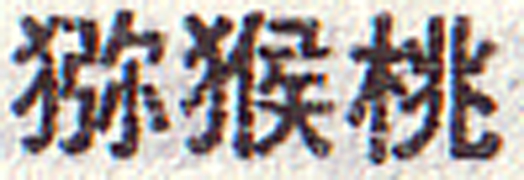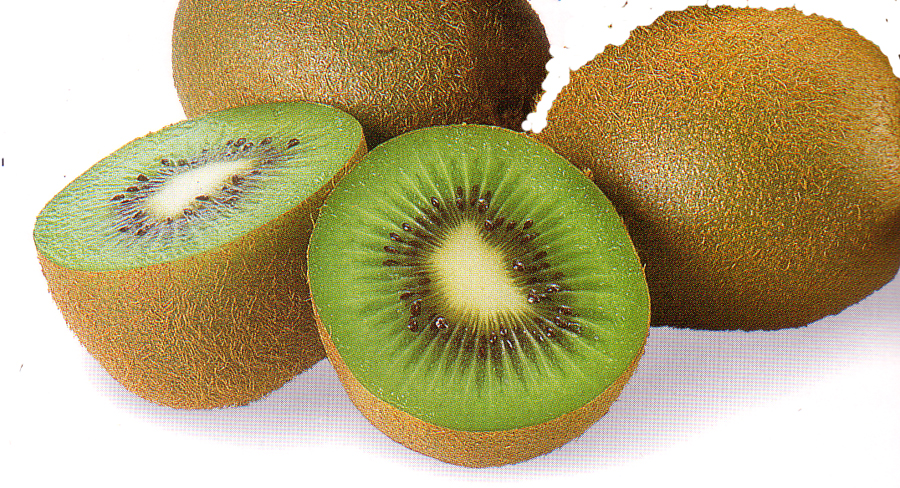
| What is Flavor and Fortune? |
| How do I subscribe? |
| How do I get past issues? |
| How do I advertise? |
| How do I contact the editor? |
Read 12979653 times
Connect me to:
| Home |
| Articles |
| Book reviews |
| Letters to the Editor |
| Newmans News and Notes |
| Recipes |
| Restaurant reviews |
| Article Index (all years, slow) |
| List of Article Years |
| Article Index (2025) |
| Article Index (last 2 years) |
| Things others say |
| Related Links |
| Log In... |
| Authors |
| Categories & Topics |
Kiwi
| by Jacqueline M. Newman |
Fruits, Desserts, and Other Sweet Foods
Winter Volume: 2007 Issue: 14(4) page(s): 11 and 12
Once known as the Chinese gooseberry, Acitinidia chinensis is not a new fruit to the Chinese. This fruit was called chang chiu, and mentioned in the Shi Jing. However, it was not always known by that name. Earlier, it went by the name of yao i, or yang tao. Early on, it was known as 'sheep peach' but now the Chinese call it ji wei.
In southern China, there are some who call it–albeit erroneously–the carombola. Why all this confusion? Perhaps because it does have several relatives including Actinidia arguta which is called the 'hardy kiwi' and Actinidia kolmikta, a northern relative with too many names to detail, though one is called the 'goat peach.'
In the western world, specifically in New Zealand, this fruit was not selling well. In a public relations coup, they renamed it the 'kiwi' after the flightless bird of the genus Apteryx. This moniker is now widely accepted. Less well known is its name of 'gooseberry' which it once was called. Use that term today, and most have no clue as to what fruit is being discussed.

 Kiwis grow on straggly woody vines. There is confusion about them because there are at least fifty different species. Some, such as Actinidia chinensis, are quite common south of the Yangtze River. Actinidia arguta is better known in China's north. With the terrific New Zealand public relations campaign and global shipping, kiwis are now shipped worldwide. They are also grown in many countries of the world.
Kiwis grow on straggly woody vines. There is confusion about them because there are at least fifty different species. Some, such as Actinidia chinensis, are quite common south of the Yangtze River. Actinidia arguta is better known in China's north. With the terrific New Zealand public relations campaign and global shipping, kiwis are now shipped worldwide. They are also grown in many countries of the world.
In the wild, the kiwi is small, the size of a very small chicken egg. Their hairy exterior is most often brown, their interior most often green. Most fruits have tiny black seeds as does the newer yellow or red fruits that have recently been hybridized; some now grown in the United States. Many green kiwi fruits are now branded 'Zespri,' and as such are grown in New Zealand or the United States.
Kiwis are mostly eaten raw, made into an alcoholic beverage, or made into a jam-like paste. The latter is used in Chinese pastries. Nutritionally speaking, the kiwi is exceptionally high in Vitamin C, about ten times greater than in apples and twice as high as that found in most citrus fruits. This fruit is also high in potassium, magnesium, and quite a few anti-oxidants and low in calories and sodium. My dietitian friends say to be sure to mention that the kiwi is a good source of folic acid and Vitamin E.
Traditional Chinese medical doctors tout the kiwi as a cold fruit, in the hot-cold dichotomy, and say it can cause diarrhea in some conditions while quite valuable for treating constipation or aiding urinary problems. They advise me to take it daily because it has anti-aging properties and as it benefits the skin. They also say that seniors should eat the kiwi often because it prevents the flu and reduces the likelihood of heart problems. Guess they know how old I am. They also recommend the kiwi as an aid to those with hepatitis.
Northern Chinese like to cook the kiwi with beef and garlic. Southern Chinese prefer to use it when making pancakes; they also like it as a fruit mixture with apricots, dried Chinese red dates, and chopped skinless almonds, and in pastries and raised dough dim sum delights. They like to add honey to pieces of the raw fruit and consume them with bubble tea in mid-afternoon.
Older cookbooks rarely give recipes for kiwi. A few newer ones do for beverages, jiao zi, pancakes, and meat dishes. Having never been served any of these by Chinese friends, we wonder if these are items to fill pages and be modern, and are not really be Chinese. No, one friend said. She told us her Mom does prefer them raw, but also cooks them, but not too often.
She referred to the fruit we now call the kiwi, as mi hou tao or 'monkey peach' and in Chinese called it teng li. She said that in Guangzhou, they grew on vines on their fence, and at the end of summer, her family store them in sand or dry them in the sun. Her Mom gave them to her later in the year when she was ill and often in a soup to cool her fever, stop her indigestion, or help her stop vomiting. She went on to advise that when dried, this fruit is called teng li gan or 'cane pear dry.' We did not find that expression anywhere else, so can not confirm it. Anyone who can, please advise.
| Pumpkin, Almond, and Kiwi Soup |
|---|
1/2 pound Chinese pumpkin, peeled and thinly sliced 1/2 cup almonds, blanched and peeled 3 Tablespoons sugar 1/2 cup peeled and diced kiwi Preparation: 1. Steam the pumpkin for fifteen or twenty minutes, drain, and cool. Then mash pushing the pumpkin through a fine strainer to remove any fibers. 2. Grind the almonds with half cup water, then strain keeping the water and discarding the nut meat. 3. Mix pumpkin, liquid from the almonds (called almond milk), and sugar, and simmer for half an hour. 4. Add kiwi pieces, and six cups of water and bring to the boil, then serve. |
| Stewed Beef with Rice and Kiwi |
|---|
1 pound beef shin, cooked in two cups of water for one hour 1 cup glutinous rice, soaked overnight, then simmered for an hour in two cups of water 2 kiwi fruit, peeled and diced 1 teaspoon salt 1 teaspoon sugar Preparation: 1. Remove meat from its cooked liquid, saving it, then remove and discard any hard muscle or fat. Finely mince the meat and set aside. 2. Drain rice, if needed, and mix it with the finely minced beef. Return one cup of beef broth, add fruit, salt, and sugar, and simmer for half an hour, then serve. |
| Kiwi Roll |
|---|
6 kiwis, peeled and diced 1/2 cup sugar 1 cup flour 1 teaspoon salt 1 egg 1 teaspoon vegetable oil Preparation: 1. Bring one cup water to the boil, add kiwi pieces and the sugar, and simmer until they make a somewhat thick paste. Cool. Set half the kiwi paste aside. 2. Mix the other half of the kiwi paste with the flour, salt, and egg. Add two tablespoons of cold water and make a thick batter. If not thin enough, add another tablespoon or two of water. Set this aside to rest for fifteen minutes. 3. Heat small (about six inches) omelet pan and swirl the oil around. Pour one fourth of the batter in, cook until set, turn over and set the other side for about one minute, then remove. Repeat until all four pancakes are made. 4. Divide remaining kiwi paste into four parts. Spread one of them on to the pancake and roll tightly. Cut on an angle in half, and put on a small serving platter. Repeat until all four are made, spread with kiwi paste, cut each in half on an angle, and put them cut end up on a serving plate. Serve them while warm. |

Copyright © 1994-2025 by ISACC, all rights reserved
Address
3 Jefferson Ferry Drive
S. Setauket NY 11720